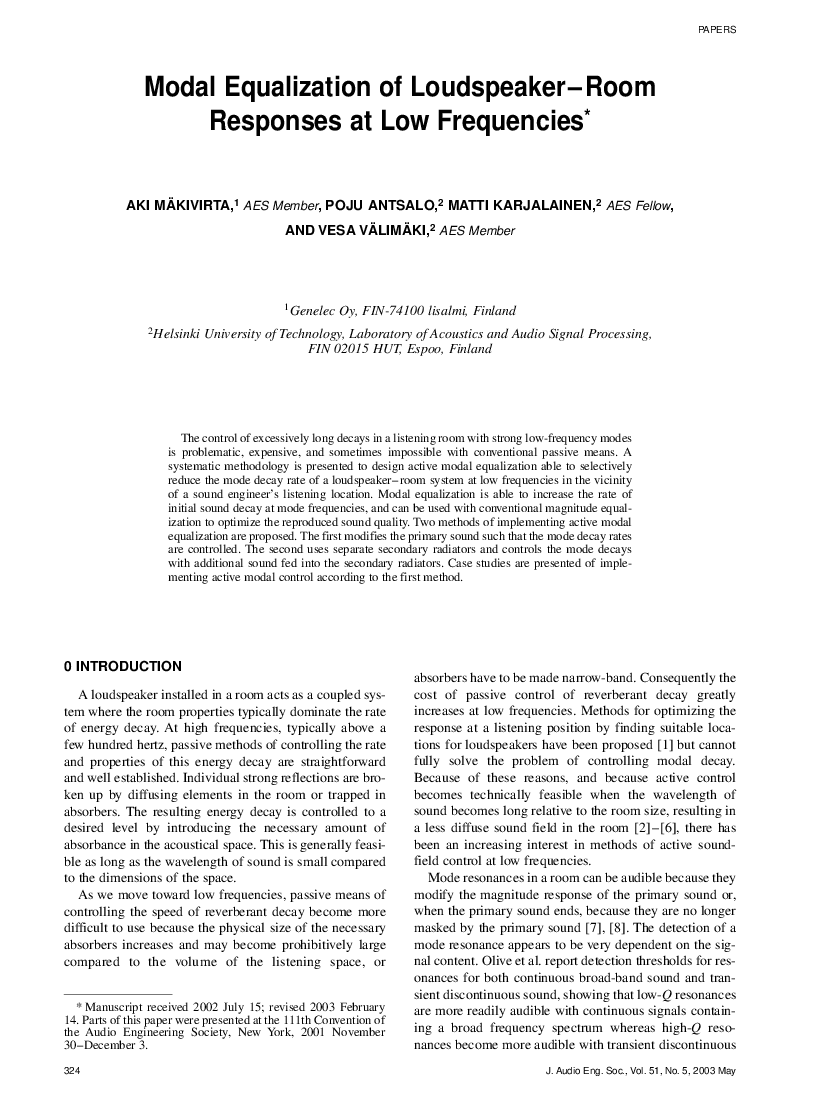Home / Publications / E-library page
You are currently logged in as an
Institutional Subscriber.
If you would like to logout,
please click on the button below.
Home / Publications / E-library page
Only AES members and Institutional Journal Subscribers can download
The control of excessively long decays in a listening room with strong low-frequency modes is problematic, expensive, and sometimes impossible with conventional passive means. A systematic methodology is presented to design active modal equalization able to selectively reduce the mode decay rate of a loudspeaker-room system at low frequencies in the vicinity of a sound engineer`s listening location. Modal equalization is able to increase the rate of initial sound decay at mode frequencies, and can be used with conventional magnitude equalization to optimize the reproduced sound quality. Two methods of implementing active modal equalization are proposed. The first modifies the primary sound such that the mode decay rates are controlled. The second uses separate secondary radiators and controls the mode decays with additional sound fed into the secondary radiators. Case studies are presented of implementing active modal control according to the first method.
Author (s): Mäkivirta, Aki; Antsalo, Poju; Karjalainen, Matti; Välimäki, Vesa
Affiliation:
Genelec Oy, lisalmi, Finland ; Helsinki University of Technology, Laboratory of Acoustics and Audio Signal Processing, HUT, Espoo, Finland
(See document for exact affiliation information.)
Publication Date:
2003-05-06
Import into BibTeX
Permalink: https://aes2.org/publications/elibrary-page/?id=12226
(1156KB)
Click to purchase paper as a non-member or login as an AES member. If your company or school subscribes to the E-Library then switch to the institutional version. If you are not an AES member Join the AES. If you need to check your member status, login to the Member Portal.

Mäkivirta, Aki; Antsalo, Poju; Karjalainen, Matti; Välimäki, Vesa; 2003; Modal Equalization of Loudspeaker - Room Responses at Low Frequencies [PDF]; Genelec Oy, lisalmi, Finland ; Helsinki University of Technology, Laboratory of Acoustics and Audio Signal Processing, HUT, Espoo, Finland; Paper ; Available from: https://aes2.org/publications/elibrary-page/?id=12226
Mäkivirta, Aki; Antsalo, Poju; Karjalainen, Matti; Välimäki, Vesa; Modal Equalization of Loudspeaker - Room Responses at Low Frequencies [PDF]; Genelec Oy, lisalmi, Finland ; Helsinki University of Technology, Laboratory of Acoustics and Audio Signal Processing, HUT, Espoo, Finland; Paper ; 2003 Available: https://aes2.org/publications/elibrary-page/?id=12226
@article{mäkivirta2003modal,
author={mäkivirta aki and antsalo poju and karjalainen matti and välimäki vesa},
journal={journal of the audio engineering society},
title={modal equalization of loudspeaker - room responses at low frequencies},
year={2003},
volume={51},
issue={5},
pages={324-343},
month={may},}